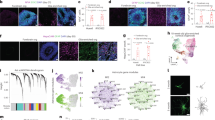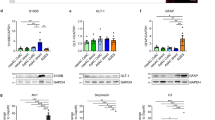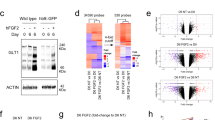Abstract
Regionally and functionally diverse types of astrocytes exist throughout the central nervous system and participate in nearly every aspect of normal and abnormal neural function. Therefore, human astrocyte subtypes are useful tools for understanding brain function, modulating disease processes and promoting neural regeneration. Here we describe a protocol for directed differentiation and maintenance of functional astroglia from human pluripotent stem cells in a chemically defined system. Human stem cells are first differentiated into neuroepithelial cells with or without exogenous patterning molecules (days 0–21). Regular dissociation of the neuroepithelial clusters in suspension, and in the presence of mitogens, permits generation of astroglial subtypes over a long-term expansion (days 21–90). Finally, the astroglial progenitors are either amplified for an extended time or differentiated into functional astrocytes on removal of mitogens and the addition of ciliary neurotrophic factor (days >90). This method generates robust populations of functionally diversified astrocytes with high efficiency.
This is a preview of subscription content, access via your institution
Access options
Subscribe to this journal
Receive 12 print issues and online access
$259.00 per year
only $21.58 per issue
Buy this article
- Purchase on Springer Link
- Instant access to full article PDF
Prices may be subject to local taxes which are calculated during checkout



Similar content being viewed by others
References
Matyash, V. & Kettenmann, H. Heterogeneity in astrocyte morphology and physiology. Brain Res. Rev. 63, 2–10 (2010).
Zhang, Y. & Barres, B.A. Astrocyte heterogeneity: an underappreciated topic in neurobiology. Curr. Opin. Neurobiol. 20, 588–594 (2010).
Zhang, S.C. Defining glial cells during CNS development. Nat. Rev. Neurosci. 2, 840–843 (2001).
Rao, M.S. & Mayer-Proschel, M. Glial-restricted precursors are derived from multipotent neuroepithelial stem cells. Dev. Biol. 188, 48–63 (1997).
Carpenter, M.K. et al. Enrichment of neurons and neural precursors from human embryonic stem cells. Exp. Neurol. 172, 383–397 (2001).
Liu, Y. et al. CD44 expression identifies astrocyte-restricted precursor cells. Dev. Biol. 276, 31–46 (2004).
Morrison, R.S. & de Vellis, J. Growth of purified astrocytes in a chemically defined medium. Proc. Natl. Acad. Sci. USA 78, 7205–7209 (1981).
Mi, H. & Barres, B.A. Purification and characterization of astrocyte precursor cells in the developing rat optic nerve. J. Neurosci. 19, 1049–1061 (1999).
Kim, H.J., McMillan, E., Han, F. & Svendsen, C.N. Regionally specified human neural progenitor cells derived from the mesencephalon and forebrain undergo increased neurogenesis following overexpression of ASCL1. Stem Cells 27, 390–398 (2009).
Zhang, S.C., Wernig, M., Duncan, I.D., Brustle, O. & Thomson, J.A. In vitro differentiation of transplantable neural precursors from human embryonic stem cells. Nat. Biotechnol. 19, 1129–1133 (2001).
Reubinoff, B.E. et al. Neural progenitors from human embryonic stem cells. Nat. Biotechnol. 19, 1134–1140 (2001).
Itsykson, P. et al. Derivation of neural precursors from human embryonic stem cells in the presence of noggin. Mol. Cell Neurosci. 30, 24–36 (2005).
Tabar, V. et al. Migration and differentiation of neural precursors derived from human embryonic stem cells in the rat brain. Nat. Biotechnol. 23, 601–606 (2005).
Johnson, M.A., Weick, J.P., Pearce, R.A. & Zhang, S.C. Functional neural development from human embryonic stem cells: accelerated synaptic activity via astrocyte coculture. J. Neurosci. 27, 3069–3077 (2007).
Hu, B.Y. et al. Neural differentiation of human induced pluripotent stem cells follows developmental principles but with variable potency. Proc. Natl. Acad. Sci. USA 107, 4335–4340 (2010).
Ruiz, S. et al. High-efficient generation of induced pluripotent stem cells from human astrocytes. PLoS One 5, e15526 (2010).
Krencik, R., Weick, J.P., Liu, Y., Zhang, Z.J. & Zhang, S.C. Specification of transplantable astroglial subtypes from human pluripotent stem cells. Nat. Biotechnol. 29, 528–534 (2011).
Yuan, S.H. et al. Cell-surface marker signatures for the isolation of neural stem cells, glia and neurons derived from human pluripotent stem cells. PLoS One 6, e17540 (2011).
Hu, B.Y. & Zhang, S.C. Differentiation of spinal motor neurons from pluripotent human stem cells. Nat. Protoc. 4, 1295–1304 (2009).
Hu, B.Y., Du, Z.W. & Zhang, S.C. Differentiation of human oligodendrocytes from pluripotent stem cells. Nat. Protoc. 4, 1614–1622 (2009).
Xia, X. & Zhang, S.C. Differentiation of neuroepithelia from human embryonic stem cells. Methods Mol. Biol. 549, 51–58 (2009).
Chen, G. et al. Chemically defined conditions for human iPSC derivation and culture. Nat. Methods 8, 424–429 (2011).
Chojnacki, A. & Weiss, S. Production of neurons, astrocytes and oligodendrocytes from mammalian CNS stem cells. Nat. Protoc. 3, 935–940 (2008).
Caldwell, M.A. et al. Growth factors regulate the survival and fate of cells derived from human neurospheres. Nat. Biotechnol. 19, 475–479 (2001).
Li, X.J. et al. Coordination of sonic hedgehog and Wnt signaling determines ventral and dorsal telencephalic neuron types from human embryonic stem cells. Development 136, 4055–4063 (2009).
Rajan, P. & McKay, R.D. Multiple routes to astrocytic differentiation in the CNS. J. Neurosci. 18, 3620–3629 (1998).
Davies, J.E. et al. Transplanted astrocytes derived from BMP- or CNTF-treated glial-restricted precursors have opposite effects on recovery and allodynia after spinal cord injury. J. Biol. 7, 24 (2008).
Wilkinson, M., Hume, R., Strange, R. & Bell, J.E. Glial and neuronal differentiation in the human fetal brain 9–23 weeks of gestation. Neuropathol. Appl. Neurobiol. 16, 193–204 (1990).
Pal, U., Chaudhury, S. & Sarkar, P.K. Tubulin and glial fibrillary acidic protein gene expression in developing fetal human brain at midgestation. Neurochem. Res. 24, 637–641 (1999).
Acknowledgements
This study was supported by the ALS Association, the National Institute of Neurological Disorders and Stroke (NS045926, NS057778, NS064578), the National Multiple Sclerosis Society (NMSS TR-3761), NYSTEM (C024406), the Bleser Family Foundation, the Busta Family Foundation, the Neuroscience Training Program (T32 GM007507) and partly by a core grant to the Waisman Center from the National Institute of Child Health and Human Development (P30 HD03352).
Author information
Authors and Affiliations
Contributions
R.K. and S.-C.Z. designed the protocol and wrote the manuscript. R.K. collected the data for figures.
Corresponding author
Ethics declarations
Competing interests
The authors declare no competing financial interests.
Rights and permissions
About this article
Cite this article
Krencik, R., Zhang, SC. Directed differentiation of functional astroglial subtypes from human pluripotent stem cells. Nat Protoc 6, 1710–1717 (2011). https://doi.org/10.1038/nprot.2011.405
Published:
Issue Date:
DOI: https://doi.org/10.1038/nprot.2011.405
This article is cited by
-
Differentiation of Neurons, Astrocytes, Oligodendrocytes and Microglia From Human Induced Pluripotent Stem Cells to Form Neural Tissue-On-Chip: A Neuroinflammation Model to Evaluate the Therapeutic Potential of Extracellular Vesicles Derived from Mesenchymal Stem Cells
Stem Cell Reviews and Reports (2024)
-
Comparison of two protocols for the generation of iPSC-derived human astrocytes
Biological Procedures Online (2023)
-
Challenges in the clinical advancement of cell therapies for Parkinson’s disease
Nature Biomedical Engineering (2023)
-
Downregulated Calcium-Binding Protein S100A16 and HSP27 in Placenta-Derived Multipotent Cells Induce Functional Astrocyte Differentiation
Stem Cell Reviews and Reports (2022)
-
Dissecting the non-neuronal cell contribution to Parkinson’s disease pathogenesis using induced pluripotent stem cells
Cellular and Molecular Life Sciences (2021)
Comments
By submitting a comment you agree to abide by our Terms and Community Guidelines. If you find something abusive or that does not comply with our terms or guidelines please flag it as inappropriate.



